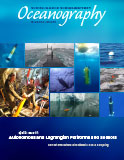First Paragraph
Western boundary currents are important oceanic components of Earth’s climate system. In the subtropics, the Gulf Stream, Kuroshio, East Australian Current, Agulhas Current, and Brazil Current contribute to poleward heat transport. Low-latitude western boundary currents, such as the Somali Current, Mindanao Current, and New Guinea Coastal Undercurrent, are key connections between the subtropical gyres and equatorial current systems. Western boundary currents are generally narrow (O(100) km wide) with strong currents (O(1) m s–1) and large property gradients, making them a challenge to both observe and simulate.

